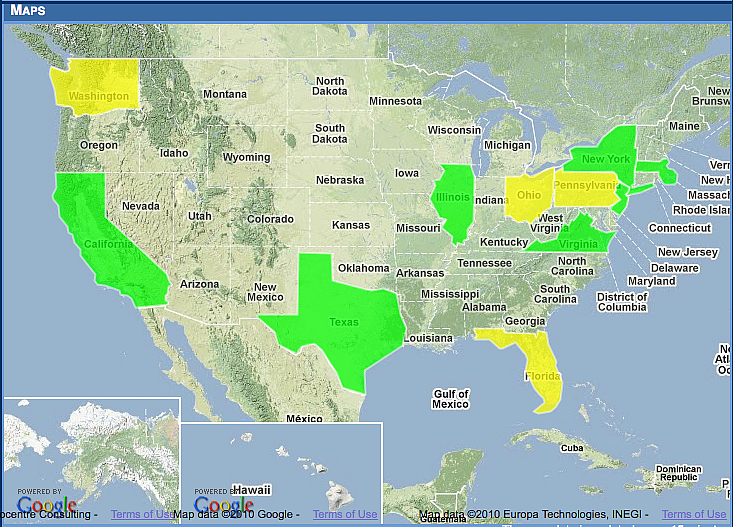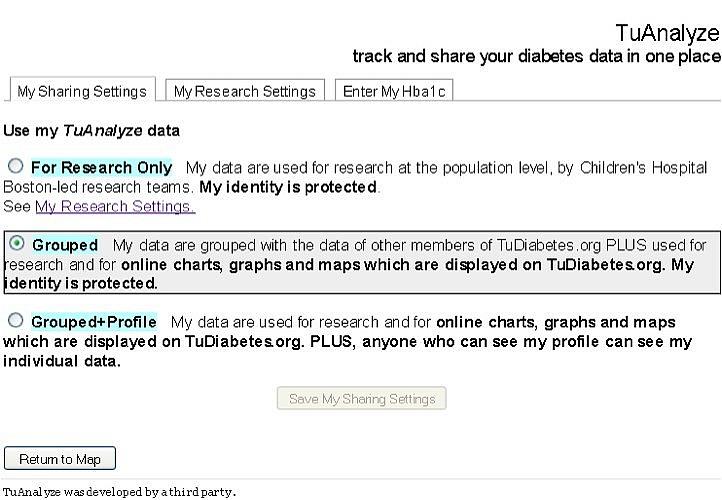TuAnalyze: Why Mapping Diabetes Data Matters
(cross-posted and edited from the original version posted in DiabetesMine)
As some of you may have heard, TuDiabetes.org has partnered with Children's Hospital Boston to develop an innovative new A1C mapping tool called TuAnalyze with support from the US Centers for Disease Control and Prevention (CDC). TuAnalyze was officially launched on the TuDiabetes site last Wednesday.
The application enables members to submit their Hemoglobin A1C data. The hemoglobin A1c (also known as HbA1c) reflects your average blood sugar level for the past two to three months.
The information submitted gets displayed in a community map on TuDiabetes, with states lighting up according to the aggregate A1C data once a threshold of participants in each state is reached. As of this writing,11 states in the US had lit up.

So, what's the point of mapping diabetes data?
- In the short term, the application certainly offers you a convenient place to track your own A1C data. Is this something you can do elsewhere? Absolutely. But
- Once the states light up, you can also see how your own numbers stack up against other people entering their A1C in your own state. You can view the total number of entries for the state, plus the average, low and high values and how the data entered are spread throughout the spectrum.
- Also, as pointed out by Ginger Vieira from Diabeteens, "it's hard to feel alone when you can look at a map lit up with A1Cs of all kinds and ranges across the entire country!"
In the mid-to-long-term, as we start discovering correlations and learning from the data, there could be valuable things for us all to learn. Just as clinical studies can indicate the connection between the intake of this or that food or medication and changes in one or more biometrics for people with diabetes, we expect similar useful studies to result from the analysis of data collected through TuAnalyze.
We could also identify, for example, trends or a correlation between people's participation in health-related social networks and their level of diabetes management. This is where the benefits of the application begin to transcend helping individuals into paths that may inform public health endeavors and research.
Are there possible negative implications from self-reported data?
Of course, all data sources have flaws. With TuAnalyze, we seek to complement the strengths of other data sources (CDC, NIH) while supplementing the weaknesses they may have. We also want to learn about participation and selection biases (what makes people be more inclined to enter their diabetes data vs. not doing it?).
We also hope to understand whether and how the research process itself can be accelerated through apps like TuAnalyze, helping reduce costs, complexity and cutting time.
Where does the TuAnalyze data get stored and how is it handled?
- Members of the TuDiabetes social network contribute their data safely and anonymously via TuAnalyze, a highly secure application developed by researchers in the Children's Hospital Informatics Program and based on the Indivo Personally Controlled Health Record. Indivo is currently in use as a personal health platform by the Children's Hospital Boston along with the member companies of the Dossia consortium.
- Through your "sharing settings" in the TuAnalyze application you select how much information about your A1C values to share – if any.
- You may choose to have your data used for research purposes, unidentified and anonymous; have your A1C values grouped with the values of other users and made available for academic research, online charts, graphs and maps displayed on TuDiabetes; or make your data visible to whomever can see your TuDiabetes profile page.
We plan to explore additional metrics in the future, and move beyond the United States to map data from around the world collected through TuAnalyze.

Going back to my first conversations about the need for better diabetes data reporting with the Children's Hospital Boston team in August 2008, I can only be proud of the carefully thought-out path we've traveled since then, to bring us to this new tool today. Where will this lead us? I don't know for sure, but it is my firm belief that TuAnalyze will significantly aid the Diabetic Community to build a shared knowledge that's bigger than any one of us.
For more screenshots from TuAnalyze, refer to this slideshow:


